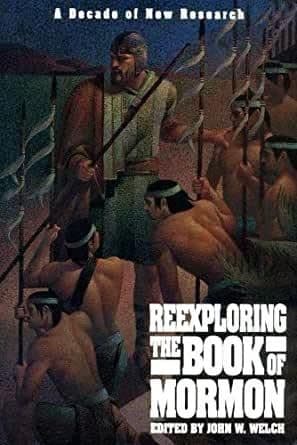Book
85 Chapters

Helaman 3:8 “They did multiply and spread, and did go forth from the land southward to the land northward.”
Many Latter-day Saints are used to thinking of the entire Western Hemisphere as the place where Book of Mormon events were played out. When they encounter facts in the scripture that demonstrate that only a limited territory constituted that scene (Mosiah 23:3 and 24:25, for example, combine to show that the cities of Nephi and Zarahemla were not very far apart), some are puzzled about how the ancient cultures of South America might connect with the book.
Archaeologists, ethnohistorians, and linguists in recent years have amassed data demonstrating beyond question that for at least four thousand years people, materials, and ideas have moved fluidly between the two American continents. This gives us an avenue for understanding how elements of the localized Book of Mormon civilization could appear over the entire hemisphere. For example, a late Peruvian people like the Incas (prominent in the thirteenth to sixteenth centuries A.D.), while having no direct connection with Book of Mormon events a thousand years earlier, can be safely assumed to incorporate genes and cultural elements from Book of Mormon peoples.
Data that prove this long-standing cultural interaction can be found in many sources. Stephen de Borhegyi has identified scores of cultural parallels between Mesoamerica (central Mexico and Guatemala) and Ecuador.1 Michael Coe was one of the first to argue persuasively that direct sea-voyaging could explain many of these similarities.2 Excavator Emilio Estrada concluded, on the strength of voluminous evidence, that “linkages were so continuous that it would be better for Ecuador to be considered an integral part of Meso America in culture.”3 This connection began very early and probably continued until the Spaniards arrived.
Allison C. Paulsen is similarly confident that “from about 1500 B.C. until [at least] about A.D. 600, the inhabitants of the [Santa Elena] Peninsula[, Ecuador,] were involved in a network of maritime trade with certain parts of Mesoamerica.”4 Donald Lathrap went so far, perhaps with overenthusiasm, as to suggest “scheduled and routinized sea trade.”5
Language comparisons also tell us that whole peoples migrated between the two continents. By the technique known as glottochronology, Evangelina Arana O. demonstrated that Quechua (the tongue of the Incas) and Tarascan (of western Mexico) may have shared a common ancestral language only forty-six centuries ago.6 A Jaredite-age connection would be indicated if that calculation is reliable. But a more recent connection is suggested by a tradition among the Huave of the Isthmus of Tehuantepec in Mexico that their ancestors had come from Peru, having been driven out by wars.7
Marshall Newman has mustered biological data to support the idea that sizable groups of people migrated southward.8 Important parts of the culture of the Olmec in southern Mexico seem to derive from the Amazon drainage, and cultures on that river’s delta in Brazil also show Mesoamerican-like features. Peru, Colombia, Venezuela, Panama, and Costa Rica were all involved in the network of movements linking the Book of Mormon homeland with the southern continent.9
Applied to the Book of Mormon, this information suggests to us that Jaredites, Nephites, Lamanites, and “Mulekites,” or their descendants, or aspects of their culture, could have filtered out over the entire hemisphere. Just as Book of Mormon peoples spread into the lands northward (see Alma 63:4; Helaman 3:8), we can assume they eventually had direct or indirect connections with the lands to the south as well.
Based on research by John L. Sorenson, November 1986. More recently on the whole topic, see Jorge G. Marcos, ed., Arqueologia de la Costa Ecuatoriana: nuevos enfoques, Biblioteca Ecuatoriana de Arqueologia 1 (Guayaquil, Ecuador: Escuela Politecnica del Litoral, Centro de Estudios Arqueologicos y Antropologicos, and Corporacion Editora Nacional, 1986).
1. Stephen F. de Borhegyi, Middle American Research Records 2, nos. 6-7 (New Orleans: Tulane University, 1961).
2. Michael Coe, “Archaeological Linkages with North and South America at La Victoria, Guatemala,” American Anthropologist 62 (1960): 363-93.
3. Emilio Estrada, “Arquelogio de Manabi Central,” Publ. Museo Victor Emilio Estrada 7 (1962): 89.
4. Allison C. Paulsen, “Patterns of Maritime Trade between South Coastal Ecuador and Western Mesoamerica, 1500 B.C.-A.D. 600” in Elizabeth P. Benson, ed., The Sea in the Pre-Columbian World (Washington: Dumbarton Oaks, 1977), 143.
5. Donald W. Lathrap, Ancient Ecuador (Chicago: Field Museum of Natural History, 1975), 61.
6. Evangelina Arana O., “Posible relaciones externas del grupo linguistico Maya,” Anales, Instit. Nac. Antro. y Hist. (Mexico) 19 (1967): 120.
7. Matthew Wallrath, “Excavations in the Tehuantepec Region, Mexico,” Transactions of the American Philosophical Society, n.s., 57 (1967): 14.
8. Marshall Newman, “A Trial Formulation Presenting Evidence from Physical Anthropology for Migrations from Mexico to South America,” in Migrations in New World Culture History, University of Arizona Social Science Bulletin no. 27 (1958).
9. See articles by Irving Rouse, Clifford Evans and Betty Meggers, and Donald Lathrap in Handbook of Middle American Indians 4 (1966); and Allison Paulsen, “Patterns of Maritime Trade,” in Elizabeth P. Benson, ed., The Sea in the Pre-Columbian World (Washington: Dumbarton Oaks Research Library and Collections, Trustees for Harvard University, 1977), 152.
Book
85 Chapters
Items in the BMC Archive are made publicly available for non-commercial, private use. Inclusion within the BMC Archive does not imply endorsement. Items do not represent the official views of The Church of Jesus Christ of Latter-day Saints or of Book of Mormon Central.